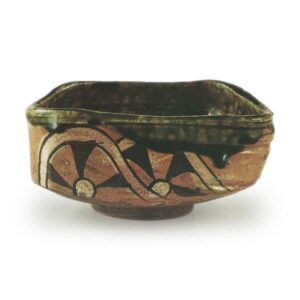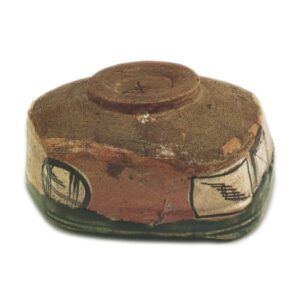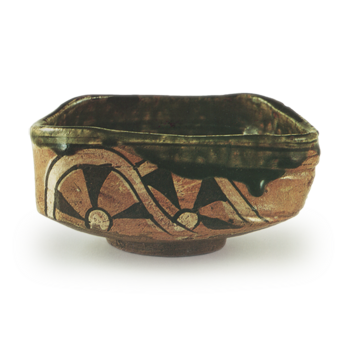

Height: 6.3cm
Diameter: 9.5-13.0cm
Outer diameter of foot ring: 5.9cm
Height of foot ring: 0.7cm
The name of this tea bowl is thought to have been derived from the color of the clay, which is a mixture of reddish brown and greenish brown, and which resembles the color of a mountain path. Unlike the black Oribe and Oribe-kuro, this is a tea bowl with a brilliant color shine.
The clay contains a little iron, and the unglazed part of the bottom has a reddish-brown, soft feel. The overall shape is slightly thin, and although it is called a “kutsu-gata” (shoe-shaped), it is actually a trapezoid, with the chamfering on all four sides being clean and smooth, and the use of the spatula being varied in both length and width. However, the pattern of the spatula is subtle, and it is not particularly noticeable at first glance. This type of trapezoidal tea bowl is often seen in Oribe ware, and while most of them are rather small and light, this one in particular has a large, relaxed foot and is a dignified work overall.
The glaze is a two-tone color, with a dark copper-green glaze unique to Oribe added on top of a reddish glaze that is also known as a base glaze. The reddish hue of this base glaze, which has a light yellowish-red tinge, is created by the iron content of the clay, and the glaze itself is a thin, transparent layer. The green glaze is applied thickly to the rim, and it flows down naturally, looking glossy. The tip of the rim is particularly dark and beautiful.
The inside of the bowl is also thickly covered with green glaze near the rim, and within the red underglaze, there are two spots of splashed glaze and stone flakes that add to the scenery.
The pattern is drawn with a free and easy brushwork that shows no particular concern for detail, and the front of the bowl is decorated with a single-wheeled cart, while the back is decorated with a scattering of square and round shapes. The white slip applied to the base of the drawing serves to enhance the black lines, and also adds a sense of vividness to the overall color tone. This is a technique unique to Oribe ware. In addition, the simple wheel design is a common subject for this type of Oribe ware, while the scattered square and round patterns are almost meaningless and improvised, which makes the design light and interesting, characteristic of Oribe ware.
The design of Oribe ware, which uses different colors for the patterned and unglazed areas, is generally regarded as a favorite of Furuta Oribe, but it is not widely known that it is actually based on the design of tie-dyeing, which was popular from the Muromachi period to the early Edo period, or what is commonly called “Tsujigahana dyeing”. According to the findings of Arakawa Toyozo, the village of Kuburi in Mino, where Shino and Oribe ware were first produced, was already a production center for tie-dyeing at the time, and in fact, the village’s guardian deity was the god of dyeing, and there was even a clan in the area whose surname was “Tsuzuri-ori” (meaning tie-dyeing). This is an important piece of information when considering Shino and Oribe.
Next, the sharp cross-shaped carving inside the foot ring is said to be the signature of Kato Shigeemon, one of the Seto Six. As mentioned in the separate section on “Masagaki”, the hand marks of Seto Rokusaku and Jussaku have been handed down, but in reality these are not the marks of the potters, but rather the marks of the owners of the kilns who placed the limited orders.
It was originally in the possession of the Kobe family, a famous family in Nagoya, and later passed to the Kuki family, who also had many famous pieces in their collection (including the famous Nezumi Shino “Mine Momiji” ware). It was later acquired by the current owner in the Kansai region.
There are no accessories other than the previous owner’s box inscription.



